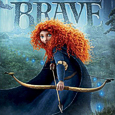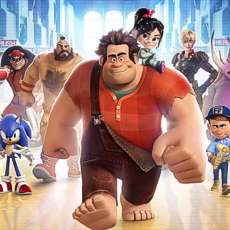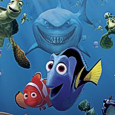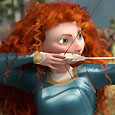Disney/Pixar (June 22 2012), Walt Disney Home Entertainment (November 13 2012), Blu-ray 3D and two-disc Blu-ray plus DVD and Digital Copy discs, 93 mins plus supplements, 1080p high-definition 2.39:1 widescreen, Dolby True-HD 7.1, Rated PG, Retail: $49.99
Storyboard:
It’s “Mother Bear” as Pixar enters the fairytale business with a magical tale of witchcraft, ancient tradition and feisty heroines…
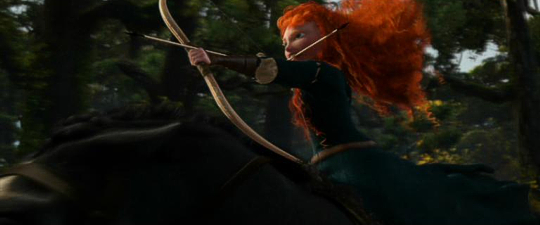
The Sweatbox Review:
Just as DreamWorks’ Rise Of The Guardians has been getting good notices for almost being everything a DreamWorks film usually is not, so does Pixar’s first foray into the kind of territory usually reserved for John Lasseter’s other preoccupation – Disney Animation Studios – not feel like any other feature to have emerged from The Lamp’s shadow before. Perhaps this is the Lasseter effect having a reverse engineering moment? With animation taking so long to come to fruition from a projects initial genesis, through development, animation and final production, it’s only really now that we are seeing his touch on the recent Disney films since the Disney Company bought out the Pixar Studio and brought Lasseter on board to run both units.
The results have been mixed, to be fair: after Lasseter was charged with “rescuing” a couple of already-in-production films he had more say over the reintroduction of traditional animation, but The Princess And The Frog and Winnie The Pooh were largely received as throwbacks to the 1990s heyday and not thought of as especially original, the result being that traditional animation has, very quietly, returned to the back-burner at the Studio, perhaps playing no small part in legendary animator Glen Keane’s recent departure. More successful, ironically with Keane in a high supervisory role, was the Studio’s take on the Rapunzel story, Tangled, itself the now infamous victim of a name change by the marketing division so as to appeal more to girls and boys.
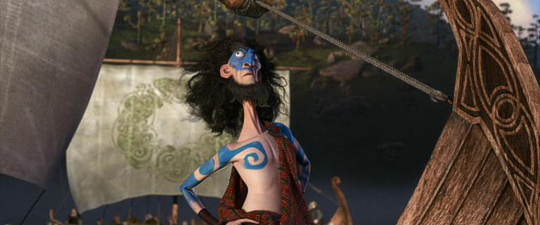
Brave has also undergone a similar boy-friendly title swap (from The Bear And The Bow, although much less controversially), proving that Pixar, now under the Disney umbrella, is also not immune to the powers that be. Announced some time ago as “Pixar’s first fairytale”, one can’t say that the film was a result of Tangled’s success, but it might have been borne from that film’s long and anguished production process. Lasseter is known not to be a huge fan of musicals: could there be a hint of “this is how it should be done” in Brave’s creation? It certainly seems there’s a clear intention to tread both where Disney has before, in the fairytale genre, and where it hasn’t, evident in the naturalistic and astonishingly realized ancient Scottish locations.
Perhaps this is why I liked the film so much; it’s very much a total departure from whatever the Studio has attempted before, from the antics of the toy room and the miniaturized dramas of the insect and undersea worlds, to things that lurk under the bed, automobile racers and adventures coming to those late in life. Brad Bird’s The Incredibles was maybe the first Pixar film to really throw a curveball in the kinds of films Pixar was becoming known for, its human characters coming to the fore for the first time and offering up a unique take on a fairly unexplored angle to superhero life. Pete Docter’s Up seemed like it could have been the next to really spin the Studio into another direction, but ultimately it was a pretty straightforward adventure film and by its no-less exciting climax its hero could have been any age in effect, given the stunts he managed to pull off without so much dislocating a hip.

It’s also interesting that, whenever the Studio takes a gamble on a project like The Incredibles or Up that they don’t seem to follow it up, despite the enormous success of those films. Bird says he has ideas for an Incredibles follow-up, but he’s otherwise tied up for the next few years, and Docter has (rather disappointingly it has to be said, at least until we see the final results) returned to sequel territory for another Monsters, Inc. that this time sees Sulley and Mike at university for a prequel outing. Maybe this is the flipside to Pixar’s taking risks with projects such as Brave, but the results are never quite as breathtaking than when they’re stretching the boundaries even if their sheer perfection production process means the final grosses are usually just as high.
I probably liked Brave because I didn’t really know too much about it. The initial teasers didn’t really spike my interest, and I did feel that what little we knew about the story sounded a little clichéd, predictable and old-hat. I missed it at the theaters for that very reason and knew I would catch it sooner or later, not really urged on by the polite but not hugely ecstatic notices and word of mouth. However, on settling back to review Brave for Animated Views I found it to be something of a minor gem. Comparisons to Tangled are fairly instant: not that this is an all-singing, all-dancing musical but a title song played over an opening montage isn’t a million miles off from how that film kickstarted itself after a prologue sequence, and the effect is much the same here.
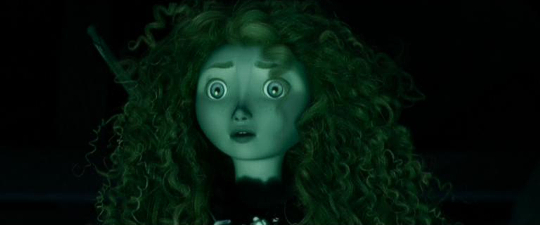
From that moment on I must say I was largely captivated…to various degrees. Jaw-dropping throughout is the Highland setting, not at all “real” and very much a Hollywood fantasy depiction borrowed almost lock, stock and barrel from Brigadoon by way of How To Train Your Dragon. But, dreamy as it is, it does look wonderfully gorgeous and, if ever your mind starts wandering in some of the less than tight story moments, there’s always something to keep the eye’s attention. The animation, naturally, also has some terrific touches to it, even if some of the characters don’t quite match the others. This is also reflected in the characters themselves: if Brave has a big issue it’s that some of them aren’t as well painted as others, especially our heroine Merida’s mother Elinor, who never really makes too much of an impact for a later event to have much emotional meaning.
A lot of things in Brave also just seem to happen just to happen. This being a fairytale there’s a witch, of course, voiced by an unrecognizable Julie Walters, but the magic she weaves seems to be suspiciously selective for the purposes of the story, especially the main, life-changing spell she casts, which is too easily reversed at the film’s ending. It’s true that all of these kinds of films have magic that is essentially easily broken, but here it’s a little too convenient, just like the ending of Avatar. The witch comes and goes when she pleases too, introducing anachronisms that would feel out of place in anything other than an animated film. There have been comparisons made to Disney’s earlier Brother Bear and, in the end, they turn out to be fair ones, although I wasn’t sure which direction the story would always take.
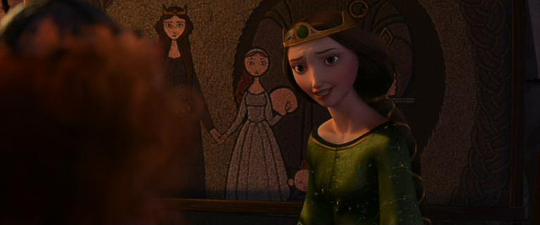
This is because it ultimately doesn’t seem to take any direction: once a curse has befallen Elinor (an okay but non-too Scottish Emma Thompson), the film seems more concerned in turning into a cartoon farce where a bear must be kept under wraps from Merida’s bear-hating father, an over the top and film-unbalancing Billy Connolly. Connolly has been something of an occasional Disney regular since Pocahontas, but here he’s been allowed to play broad and loud with his doting father figure, in danger of toppling the movie over: there’s nothing wrong with being larger than life, but a character can’t really be larger than the movie! Apart from this, Connolly is actually quite fun, a boisterous character that explains where Merida gets her traditional Disney princess feistiness from.
As Merida, authentic Scot Kelly MacDonald voices her as, it has to be said, quite an annoying character. At times, I wished it were her that were cursed, since despite the prerequisite spirited nature, she ultimately doesn’t do a lot to propel the story. Once she and her mother are cooped up in their castle, trying to dodge her bear-hunting dad, Brave gets awfully stuck quite literally running around in circles. Much of this could be down to the production process: at one time The Bear And The Bow was said to be a personal project for the much praised animation director Brenda Chapman, finally landing her first solo gig here. Well, perhaps it was too personal for the Pixar brass: Chapman left the film – and Pixar – and her screenplay, co-written with Irene Mecchi, got another two rewrites from co-director Steve Purcell and eventual director Mark Andrews.

It’s interesting that they’re both men, and that the switch in direction also brought about the Tangled style title change to Brave. Chapman retains her director’s credit – by all accounts a lot of her work remains in the film – but there’s no denying or mistaking a movie that’s been re-jigged around, a lot. While coherent and never feeling like there are any “missing” scenes, the whole thing just feels a little undercooked, as if it missed out on further development from Chapman and Mecchi, and then got picked up and finished by Purcell and Andrews without the required amount of improvement that usually comes on a film like this through its many years of production. Which is why I’m still baffled as to why I liked it so much overall. I suppose what feels most refreshing is that it totally breaks away from the buddy-buddy ambience of the usual Pixar film, where everyday small-talk is present between friends and everyone can be associated with immediately.
Here I wasn’t sure who the characters were and what they were up to in the opening minutes of the film. Everything is much simpler and, like Merida, more direct and to the point, not to labor the parallels with her weapon of choice, a bow and arrow. It’s just that then, once the setting up as been dealt with, there isn’t really anywhere for the story to go. There’s a subplot about a prince who becomes a bear, and for a moment everything looks a wee bit too predictable before things spiral off in another direction that ultimately doesn’t feel as satisfactory, in a way, while also being just what the conclusion needs. Brave, then, is a conundrum of a movie; a film that entertains and absolutely wows in terms of craftsmanship, but never quite gets going or, more to the point, gets going and then doesn’t really have anywhere else to go.
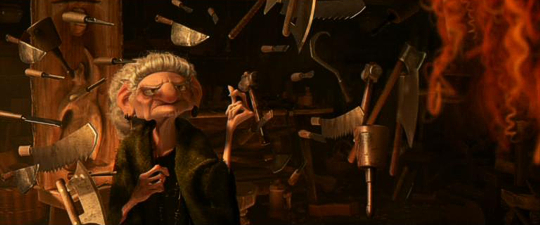
The entire mid-section, often weighty in Pixar terms, is saggier than most, but then again we have a less than lengthy running time that wraps things up, sans credits, in around 85 minutes. I think the thing I liked most about Brave was that it felt more like a Disney movie, not just because of the fairytale connotations but because it somewhat resembles a throwback to a simpler time, much as Up also did for me. It perhaps doesn’t have the nuances of a traditional film from the Studio, or ultimately the depth of some of them, but in a way I found that quite energizing: I just hope Pixar can run with stuff like this and maybe develop them more, rather than get stuck in a rut of sequels and franchises when stories like these, even if they don’t reach a true potential, are still much more invigorating, interesting and nutritiously entertaining.
Is This Thing Loaded?
Making Brave a must-own on Blu-ray is this excellent Ultimate Collector’s Edition, which opens up the doors of Pixar to explore the production in a way I don’t think we’ve seen on disc for sometime! Split into a five disc combo, the regular BDs get top priority in the packaging listing, suggesting that Pixar don’t place as much emphasis on this aspect as others. Discs One and Two (yes, the film gets an entire platter dedicated to the supplements, but not without a minor caveat mentioned below) are where the movie and HD extras are, but there’s also a lot of good stuff to go through on the first disc before making it to the second.
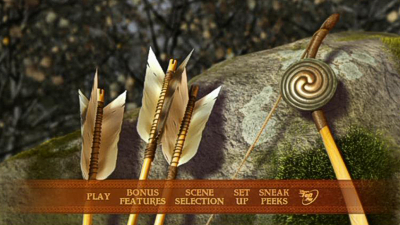
Pick of the bunch is a feature-length Audio Commentary with co-directors Andrews and Purcell, story supervisor Brian Larsen and editor Nick Smith that’s well worth a listen. Andrews is perhaps a little too exuberant, a surprising character trait given the otherwise held-back restraint of the resulting movie, which suggests Chapman’s contributions may have been more than is let on here, and it’s a shame that we can’t naturally hear from his directorial predecessor, but fair play to Disney and Pixar for including a track at all when the upheaval between helmers could have resulted in too many complications to warrant one.
The discussion is otherwise extensive, delving into a scene-by-scene deconstruction of the movie and what went in to almost every element, from character design and voice casting, story development (where Chapman gets her dues) and animation advancement, to creating the locations and world of Brave including its score. The participants are naturally proud of their film, and this is a packed track of information, the first of the many bonuses that could bring about a fresh appraisal of the end result, although it’s a bit of a shame that the picture-in-picture Cine-Explore feature hasn’t been utilized here.
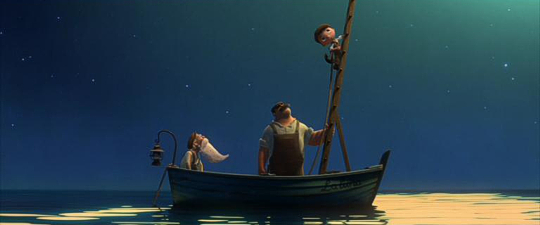
A selection of two Short Films (in 2.39:1 widescreen) pull up Brave’s theatrical companion, the beautifully whimsical La Luna (7 mins, also the lone extra on the BD-3D disc), in which a young boy helps his father and grandfather tend to their responsibilities on the moon. Don’t worry, it’s not as nutty as that sounds, being a truly poetic and sweet little film, full of flights of fancy and, like the best Pixar shorts, told completely in pantomime. The second, the cover-hyped The Legend Of Mor’Du (6:50) is perhaps the most disappointing and pointless of all the Pixar shorts, a very basically Flash-animated thing that supposedly tells the origin of the bear who took Merida’s father Fergus’ leg.
It begins promisingly, with a CG sequence and various still images slowly becoming more and more animated, until one realises that this has been put together rather inexpensively, the story content only rehashing stuff we know from the main feature’s backstory. Much better is a series of Behind The Scenes featurettes, adding up to a total of around 50 minutes and focusing more on the artistic side of things rather than vocal talent. I’m a little perplexed as to why all the supplements haven’t been moved to the second disc, since there’s well over an hour of material squished onto this first disc when Disc Two only totals well under an hour – one would have thought to give the movie all the space it needs and separate the extras out with more balance.

Anyway, these featurettes do their required job of filling us in on Brave’s production, admirably not trying to make Chapman disappear from the process: indeed, she gets to utter the first words on the genesis of the project. Her departure is of course expertly skirted around, but it’s cool that Pixar haven’t tried to reverse history and remove her, Jeffrey Katzenberg style, from documented content on the film’s production. Brave Old World is coverage of Pixar’s research trip to Scotland, revealing the amazing real-life inspiration for the locations of Brave, with Merida & Elinor examining the two lead female characters, mostly from an animator’s point of view while also briefly hearing from their vocal talents.

Picking up from the same theme, Bears is just as self-explanatory and concerns two aspects of one of the characters to undergo an enormous transformation during the movie. Looking at the animal artistry itself, this is an interesting piece and shows how the animators found the right balance between pure primal instinct and anthropomorphism. Brawl In The Hall shifts the attention on to the four clans that come to blows in the film, and reading between the lines one might surmise that Andrews was brought in to bring a more boisterous humor and testosterone to Brave, resulting primarily in this brawl sequence, which ultimate gets a rather inordinate amount of time spent on its dissection.
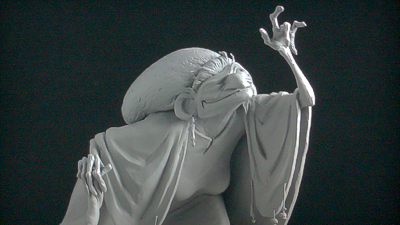
Further exploration is found in Wonder Moss, looking at the film’s major technological breakthrough, and as usual it’s something small, fairly insignificant and probably totally unnoticed by the majority of the audience – but without it, the locations of Brave would not have appeared half as authentic. Pixar’s first fairytale’s roots are observed in the simply titled Magic, taking a look at the story and enchanted aspects of the film, while the animators themselves reveal how all that was turned into a CGI movie in Clan Pixar, recounting how the crew let off steam, Scottish style. These are good, well produced featurettes, even if they all seem slightly run of the mill, and I’d have liked to have more of a balance between the animators and vocalists’ roles.

Various abandoned concepts get an all-too-brief airing in the final two offerings: Once Upon A Scene (7:47) is a glimpse into alternate versions of the film, including different openings and numerous other changes. Expanding on this, a series of four Extended Scenes offer up around thirteen minutes’ worth of sequences that were trimmed for the final movie. Meet The Lords, Triplets’ Distraction and The Ruins are mostly completed animation, their ultimately removed portions denoted by a helpful pop-up icon that identifies the “missing” moments in the eventual release, with Blockade shown via rough blocking and a mix of final animation. Andrews is on hand to intro each, but mostly these are scene trims with a few shots added back in here and there.
On to Disc Two, and it does seem that some of this material might have been better grouped with that on the first platter. For instance, Fergus & Mor’Du: An Alternate Opening (2:40) seems to belong with the deleted material we’ve just seen, but it feels separated and disjointed for that here. Andrews intros again, this being more of what was touched on before, where Fergus loses his leg to Mor’Du in a cold and desolate forest, in a mix of rough blocking and final animation. Fallen Warriors (2:08) is pretty much more of the same, a montage of single shots cut from Brave after they had been fully animated and rendered.

Again feeling like it should have been grouped with the rest of the Scottish-themed extras, Dirty Hairy People (3:33) looks at the time period of Brave, having fun depicting their supposedly feral origins, poor personal hygiene…and hair. Lots and lots of dirty hair. It Is English…Sort Of continues the exploration of Pixar’s Scotland, focusing on the language – or rather the slang phrases – of Brave and, finally, a little of the authentic vocal talent that brings it to life, as per Chapman’s wishes. Running just under four minutes, this is probably the most enjoyable of the snippets here, speaking as it does to a number of genuine Scots – including composer Patrick Doyle – that contributed to the film.
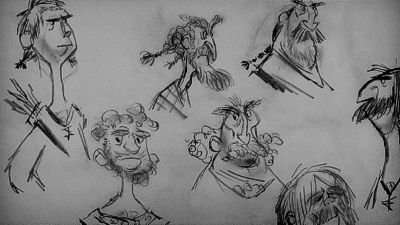
Angus and The Tapestry both very simply take brief three/four-minute looks at Merida’s horse and the family heirloom that plays such an integral part in the film’s story. Close to finishing off the extras is something rarely seen on Disney discs of recent times: a section of Promotional Pieces that not only include a number of TV clips – Feast Your Eyes! Montage (Wee Bits of Animation), Relics, Clan Dun Broch, Launch and Flying Guts Theater – but also some actual theatrical trailers from the US, Japanese and UK releases. Although there’s no Play All option – which would have been welcome across all the sections mentioned above – these add up to around 14 minutes of content.
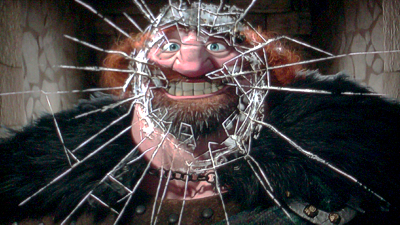
Finally, another rarity on Disney discs is present in a welcome Art Gallery, set to music cues from the score and allowing for good close up study of the film’s Characters (178 images), Color Keys (95), Development Art (96), Environments (65) and Graphics (37), even if posters unfortunately are a no-show. The included DVD features the movie, looking sharper than most recent transfers have done recently, along with La Luna and The Legend Of Mor’Du shorts and the Audio Commentary, while across all discs there are the usual Sneak Peeks for Monsters University, Planes, Peter Pan Diamond Edition, Disney Junior’s Sophia The First and Finding Nemo.
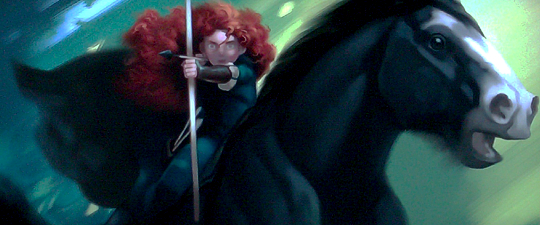
Case Study:
Disney’s now traditional 3D packaging makes Brave stand out, with a silver border and lenticular card artwork giving nice depth to Merida, the title treatment and the subtle bear in the background. Interestingly, this Ultimate Collector’s Edition doesn’t otherwise make a big play for the 3D aspect: the title itself is Brave, not Brave 3D as Disney and other animated titles often promote themselves on other releases, which is the way it should be, the 3D being an added attraction to the pack and not the name of the movie. This slipcover art is replicated on the sleeve inside, although I think I do prefer the montage of Merida and her family on the also-available regular Blu-ray set to the solemn image of Merida alone on the 3D edition.
Inside the discs get some nice artwork themselves, including the included DVD – something of a rarity itself these days, although the Digital Copy disc is a hideous shade of flat yellow. Stickers promote the new short while there’s the Movie Rewards insert and – proving Brave is seen as one of Disney’s bigger end of year titles – a promotions booklet featuring Brave merchandise and other Disney and Pixar titles’ releases to Blu-ray. There’s nothing awesome announced, but it’s nice to see a brace of classic and contemporary Disney titles coming to Blu, including Fred MacMurray’s flubber comedies, Babes In Toyland and Pollyanna.
Ink And Paint:
As mentioned above the locations of Brave are made of pretty awe-inspiring stuff, and the regular Blu-ray presentation reproduces every rock and piece of bear fur absolutely faithfully, without any major aliasing that I could pick out. This really is a rock-solid image, given great depth by the cinematography and direction that plays with the 3D format but doesn’t pander to it, creating a vibrant perspective whether you’re watching it flat or with the added D.

On the Blu-ray 3D disc, the image comes alive even more, offering perhaps the best added layering to an animated film since I saw Tangled in the theater. I don’t think that home 3D has the same impact as a really good theatrical presentation, but Brave is better than most. In fact, the only “issue” with the film is that it’s not a story to fully take advantage of the format, even if the brighter lighting, even in the magical night scenes, means that it all looks great.

The movie works just as well without the extra dimensionality, but for those with the option, I have to say that the 3D is sharp and well worth the outlay: there’s a crispness here that’s often missing in all but a few shots, and a layering that really brings one into those lush Scottish landscapes whenever the storytelling gets a wee dull. Brave is easily reference quality material, and in a year of terrific animated releases is probably the best looking title out there at the moment.
Scratch Tracks:
It’s interesting to me again, as with the recent release of DreamWorks’ Madagascar 3, that some Studios seem to prefer the sound of Dolby True-HD, which is what we are serviced with here, over the more standardized uncompressed DTS format on Blu-ray. This is by no means a consistent Pixar quirk: new release Finding Nemo sports a Dolby track while Up’s fresh 3D disc reverts to DTS, but to be honest I find it hard to split the difference, unlike the DVD days when DTS could only be matched by Dolby in EX form.
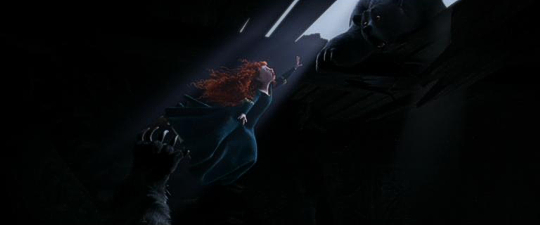
The bottom line is that a good track is a good track, and Brave is a very good track, and for a change one of the standout moments is not a loud chase scene (the run-around the castle is too laborious for that) but the quieter moments, especially Merida’s breaking of her potential suitors’ arrows where the sound particularly helps the slow-mo animation (always tricky) achieve its aim (sorry!). A variety of formats – including a handy Dolby 2.0 near field mix for regular TV speakers – offer dubs and subs in English, French and Spanish.
Final Cut:
Brave finds John Lasseter’s stewardship of Disney and Pixar merging like never before, as if a memo meant for one Studio was sent to the other, mixing sensibilities as well as subject matter. It’s not such a nutty thought: Pixar seems to have been on something of a slide recently, with the artistic low-point of Cars 2 and further reliance on another sequel in Monsters University not dominating the animation landscape while Disney has climbed back towards the top with Tangled and the current surprise success of the videogame-inspired Wreck-It Ralph. The result of this swapping may not be the strongest film either Pixar or Disney have ever released, and I can understand the points of view of those who just didn’t warm to the film. For some reason, I liked it enough myself, and the film’s Ultimate Edition treatment here easily makes it a natural addition to the growing Pixar collection.
 | ||
 |



